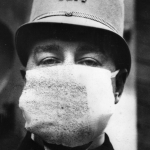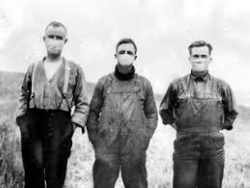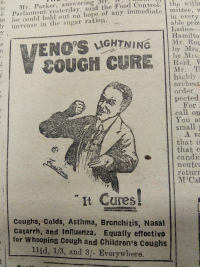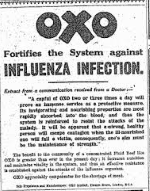The Influenza Pandemic in Ireland – 1918-19
Published on 11th April 2020
 In 1918, news started to filter through of a ‘mystery malady’, a ‘mysterious war disease’. It appeared to originate in Spain as it was first widely reported there, hence the name it has been called ever since, the Spanish Flu. Although, first reported in Spain, the disease probably originated in a different location. Regardless of its origin, the flu wreaked havoc across the globe, claiming the lives of at least 40 million people from 1918 to 1920. The true figure will never be known. It is estimated that one fifth of the world’s population caught the flu.
In 1918, news started to filter through of a ‘mystery malady’, a ‘mysterious war disease’. It appeared to originate in Spain as it was first widely reported there, hence the name it has been called ever since, the Spanish Flu. Although, first reported in Spain, the disease probably originated in a different location. Regardless of its origin, the flu wreaked havoc across the globe, claiming the lives of at least 40 million people from 1918 to 1920. The true figure will never be known. It is estimated that one fifth of the world’s population caught the flu.
The flu started to make its way to Ireland by the early summer of 1918. On 10 June, an ‘unusual outbreak of illness’ was reported in Belfast, mostly amongst soldiers and female factory workers. By the end of June, 200 cases were reported in Dublin, 60 children in one convent alone, 40 workers in a factory.
 The flu was described by some in Dublin as a plague by early July. Death numbers were started to filter through, 2 in Dublin, 5 or 6 in Lurgan, 100 in Belfast. There were numerous deaths in Derry. Several people were falling on the streets in Cork. The flu came in two forms, one a mild type of illness, the second more severe. Dying patients sometimes had temperatures as high as 109 degrees Fahrenheit, became unconscious and twitched frequently. They usually died between the sixth and eleventh days of the disease.
The flu was described by some in Dublin as a plague by early July. Death numbers were started to filter through, 2 in Dublin, 5 or 6 in Lurgan, 100 in Belfast. There were numerous deaths in Derry. Several people were falling on the streets in Cork. The flu came in two forms, one a mild type of illness, the second more severe. Dying patients sometimes had temperatures as high as 109 degrees Fahrenheit, became unconscious and twitched frequently. They usually died between the sixth and eleventh days of the disease.
From the middle of July, the first wave of the flu started to recede. When the second wave struck in October 1918, it was clear to most that the country was in the grips of a severe flu pandemic. Like the first wave, Leinster and Ulster were the areas most affected by the second wave. The second wave was far more destructive than the first. There were many reports of unimaginable horrors inflicted on whole families.
There was a case of a man in Clontarf returning home after burying his two sons to find his wife dead too. In Enniscorthy in Wexford, 3 young children from the one family died on the same day. Schools in Dublin city and suburbs were severely affected and were closed down. Absenteeism was rife in businesses. October and November of 1918 saw a paralysis in trade.
 The second wave, the deadliest of the three waves, dissipated in most places in Ireland by the end of November. The third wave came in February 1919. In Gloucester Prison, Pierce McCan, 35 years-of-age, newly-elected TD for Tipperary East died from the flu on 6 March. There was very little consensus within the medical profession on what was the most effective treatment for the flu. A mixture of whiskey and hot water with sugar was the most widely available. Non-prescription medicines were in high demand as people self-medicated during the pandemic. Hugh quantities of tonics, cough medicines and poultices were sold by pharmacies. Bovril and other beef teas like Oxo were very popular too. Despite all the tonics promoted and sold, bed rest and nursing were still considered the best way of beating the flu.
The second wave, the deadliest of the three waves, dissipated in most places in Ireland by the end of November. The third wave came in February 1919. In Gloucester Prison, Pierce McCan, 35 years-of-age, newly-elected TD for Tipperary East died from the flu on 6 March. There was very little consensus within the medical profession on what was the most effective treatment for the flu. A mixture of whiskey and hot water with sugar was the most widely available. Non-prescription medicines were in high demand as people self-medicated during the pandemic. Hugh quantities of tonics, cough medicines and poultices were sold by pharmacies. Bovril and other beef teas like Oxo were very popular too. Despite all the tonics promoted and sold, bed rest and nursing were still considered the best way of beating the flu.
By the end of Spring 1919, the flu finally ran its brutal course in Ireland. It had caused huge devastation throughout the country. An official figure of 20,057 deaths were recorded as being caused by flu during the three waves, although this is likely to be a conservative figure. There were also a lot more deaths from pneumonia, an excess figure of 3,231 deaths from pneumonia in 1918 and 1919 which also can be attributed to the Influenza Pandemic giving a figure of at least 23,288 deaths directly related to the epidemic.

 Assuming the same for Ireland as the worldwide trend of a 2.5 per cent fatality rate, an approximate number of 800,000 Irish people caught the illness, about one fifth of the population. Taking excess pneumonia deaths into account, the figure was 900,000 people.
Assuming the same for Ireland as the worldwide trend of a 2.5 per cent fatality rate, an approximate number of 800,000 Irish people caught the illness, about one fifth of the population. Taking excess pneumonia deaths into account, the figure was 900,000 people.
Mortality in Ireland, like elsewhere, peaked in the mid-life period, between the ages of 25 and 34. There was a surprisingly strong correlation between the social classes of those who died, it was a socially neutral disease. It was more job-dependent than class-dependent. Those who worked with the public were more likely to catch and, therefore, die from the flu. The influenza pandemic, ultimately, left behind a trail of destruction in Ireland, affecting everyone in every county from all classes and creeds.
Blog post by: Cormac Moore, Historian.